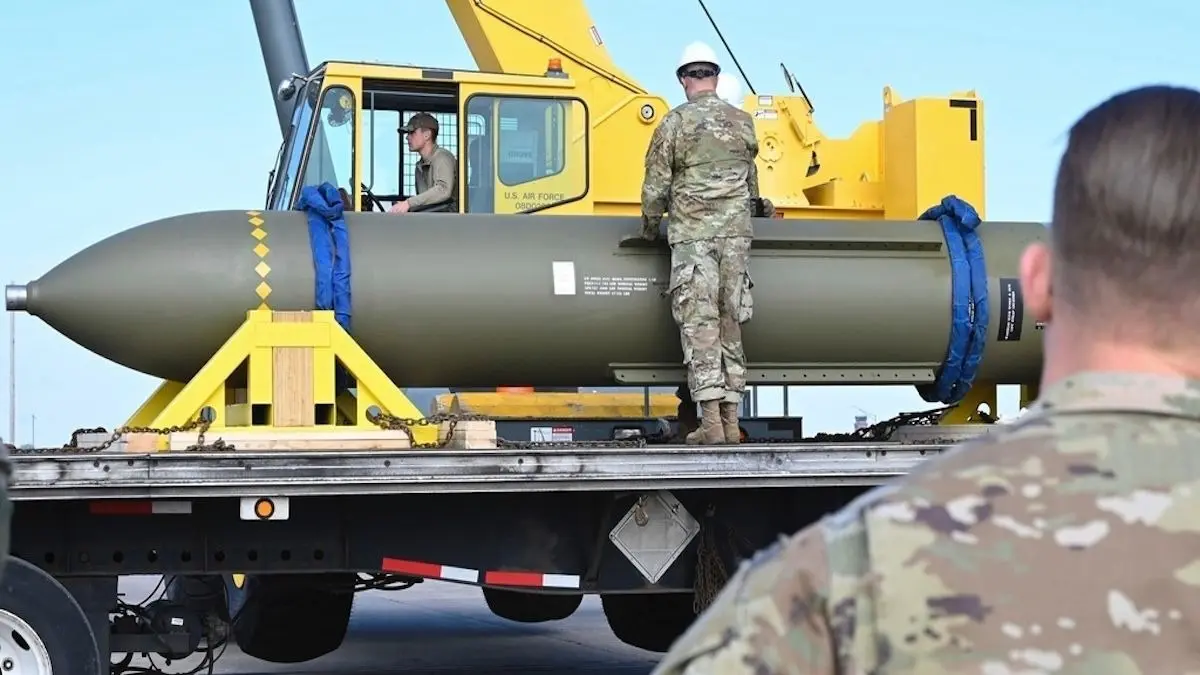Updated 22 June 2025 at 13:39 IST
What Is the GBU-57? Inside the US Military's Most Powerful 'Bunker-Buster' Bomb Used to Strike Iran's Nuclear Sites
The GBU-57, the US military’s most powerful bunker-buster bomb used to strike Iran’s nuclear facilities.
- World News
- 4 min read

The GBU-57, also known as the Massive Ordnance Penetrator (MOP), is the United States military’s most powerful conventional bomb. It was recently used in airstrikes on key Iranian nuclear sites, including the Fordow facility. This bomb is specifically designed to target and destroy deeply buried and heavily fortified structures, making it a crucial tool in military operations against well-protected targets like Iran’s nuclear facilities.

What Makes the GBU-57 So Powerful?
The GBU-57 is one of the largest bombs in the US arsenal, weighing around 30,000 pounds (13,600 kilograms) and carrying 5,300 pounds of explosives. Its massive size allows it to penetrate up to 200 feet (61 meters) of reinforced concrete and rock before detonating. This makes it ideal for targeting deeply buried sites such as Iran’s Fordow nuclear facility, which is protected by several layers of rock and soil.
The bomb's GPS guidance system ensures precise targeting, allowing the US military to strike with extreme accuracy. This technology is critical for missions involving highly fortified or underground targets.
How Is the GBU-57 Delivered?
Due to its immense size and weight, the GBU-57 can only be carried by the B-2 Spirit stealth bomber. The B-2 is one of the most advanced aircraft in the world, known for its stealth capabilities, which allow it to evade enemy radar. The bomber can carry up to two GBU-57 bombs at once, making it the perfect platform for delivering such a large weapon to highly protected sites like Iran's Fordow.
Advertisement
The B-2 bomber is capable of reaching anywhere in the world within hours, with a range of up to 7,000 miles without refueling and 11,500 miles with a single refuel.
Why Was the GBU-57 Used in Iran?
The GBU-57 was chosen for the recent strikes on Iran’s nuclear sites because these facilities are buried deep underground and heavily fortified. The Fordow facility, located near Qom, is one of the most fortified nuclear sites in the world. It is buried 60 to 90 meters underground, making it nearly invulnerable to conventional weapons.
Advertisement
The GBU-57's ability to penetrate deep into the earth before exploding makes it the only bomb in the US arsenal capable of neutralizing such heavily protected targets. The strike on Fordow, along with others on the Natanz and Esfahan facilities, was intended to prevent Iran from advancing its nuclear program.
Why Is the GBU-57 Significant?
The GBU-57 is a critical weapon for modern military operations, particularly when dealing with underground and hardened targets. It has become the weapon of choice for missions requiring precision and devastating impact on deeply buried facilities.
This particular mission marked the first operational deployment of the GBU-57, showcasing its capability to take down even the most secure nuclear facilities in the world. Experts consider this strike a game-changer, demonstrating the US military's ability to destroy high-value, deeply buried targets with precision.
Fordow: A Tough Target for Conventional Bombs
The Fordow facility is considered one of the toughest nuclear targets due to its depth and the layers of rock and concrete protecting it. Built into the side of a mountain, the facility is designed to withstand conventional airstrikes. The use of the GBU-57 was crucial in penetrating these defenses and effectively neutralizing the site’s uranium enrichment capabilities.
While the site is also protected by advanced surface-to-air missile systems, these defenses were likely weakened during previous Israeli airstrikes, making the GBU-57 even more effective.
Why Did the US Get Involved?
The US's involvement in using the GBU-57 came after years of monitoring Iran’s nuclear sites. US military surveillance, along with intelligence from Israel, allowed for the precise targeting of these facilities. The goal was to halt Iran’s nuclear ambitions and ensure the security of its allies, particularly Israel.
The GBU-57 is a powerful tool in the US military's arsenal, designed specifically for situations where other bombs would fail. Its successful use in the recent airstrikes against Iran is a testament to the advanced capabilities of the US armed forces.
Published By : Navya Dubey
Published On: 22 June 2025 at 12:51 IST
